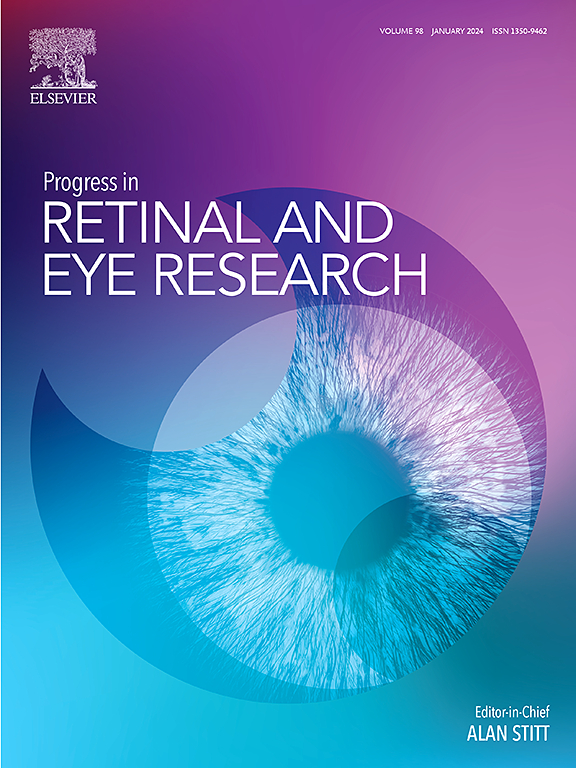Bisretinoid lipofuscin, fundus autofluorescence and retinal disease
IF 14.7
1区 医学
Q1 OPHTHALMOLOGY
引用次数: 0
Abstract
Retinal pigment epithelium emits an inherent autofluorescence that originates from naturally occurring fluorophores when excited by short-wavelength light (SW-AF) in the spectral range between 400 and 590 nm. Peak excitation is 490 nm. The autofluorescence emission occurs at wavelengths between 520 and 800 nm with a peak of approximately 600 nm. For clinical purposes this emission is recorded as fundus autofluorescence either using a confocal scanning laser ophthalmoscope (cSLO; 488 nm excitation); a modified fundus camera or by ultra-wide-field ophthalmoscopic technology. The topographic distribution and intensities of fundus autofluorescence are modulated by superior-inferior differences in retinal illuminance. The autofluorescence distribution also departs from normal in the presence of retinal disease; accordingly these changing patterns assist in the diagnosis and monitoring of the disorders. The cellular source of SW-AF is consistent with an origin from a group of di-retinaldehyde (bisretinoid fluorophores) compounds that are produced randomly in photoreceptor cells and constitute the lipofuscin of the retinal pigment epithelium. Bisretinoids also contribute to retinal disease processes. Here we will primarily address this family of bisretinoid fluorophores since they account for the spectral, age- and disease-related properties of retina lipofuscin and SW-AF. Moreover, the differing absorbances exhibited by the members of this group of fluorophores accounts for the range of excitation wavelengths that elicit fluorescence emission from RPE lipofuscin and from the fundus. That range is consistent with emission from a family of fluorophores, not a single fluorophore.
类双维甲酸脂褐素、眼底自身荧光与视网膜疾病
视网膜色素上皮在400 ~ 590nm的光谱范围内受到短波光(SW-AF)激发时,会发出固有的自身荧光。激发峰为490 nm。自身荧光发射发生在波长520至800 nm之间,峰值约为600 nm。对于临床目的,这种发射被记录为眼底自身荧光,或者使用共聚焦扫描激光检眼镜(cSLO;488 nm激发);改良眼底相机或超宽视场检眼镜技术。眼底自身荧光的地形分布和强度受到视网膜照度高低差异的调节。存在视网膜疾病时,自身荧光分布也偏离正常;因此,这些变化的模式有助于疾病的诊断和监测。SW-AF的细胞来源与一组二视黄醛(类双维甲酸荧光团)化合物的来源一致,这些化合物在感光细胞中随机产生,构成视网膜色素上皮的脂褐素。类双维甲酸也有助于视网膜疾病的进程。在这里,我们将主要讨论这个家族的类双维a荧光团,因为它们解释了视网膜脂褐素和SW-AF的光谱、年龄和疾病相关特性。此外,这组荧光团成员所表现出的不同吸光度说明了激发波长范围,引起RPE脂褐素和眼底的荧光发射。这一范围与一系列荧光团的发射相一致,而不是单一的荧光团。
本文章由计算机程序翻译,如有差异,请以英文原文为准。
求助全文
约1分钟内获得全文
求助全文
来源期刊
CiteScore
34.10
自引率
5.10%
发文量
78
期刊介绍:
Progress in Retinal and Eye Research is a Reviews-only journal. By invitation, leading experts write on basic and clinical aspects of the eye in a style appealing to molecular biologists, neuroscientists and physiologists, as well as to vision researchers and ophthalmologists.
The journal covers all aspects of eye research, including topics pertaining to the retina and pigment epithelial layer, cornea, tears, lacrimal glands, aqueous humour, iris, ciliary body, trabeculum, lens, vitreous humour and diseases such as dry-eye, inflammation, keratoconus, corneal dystrophy, glaucoma and cataract.

 求助内容:
求助内容: 应助结果提醒方式:
应助结果提醒方式:


